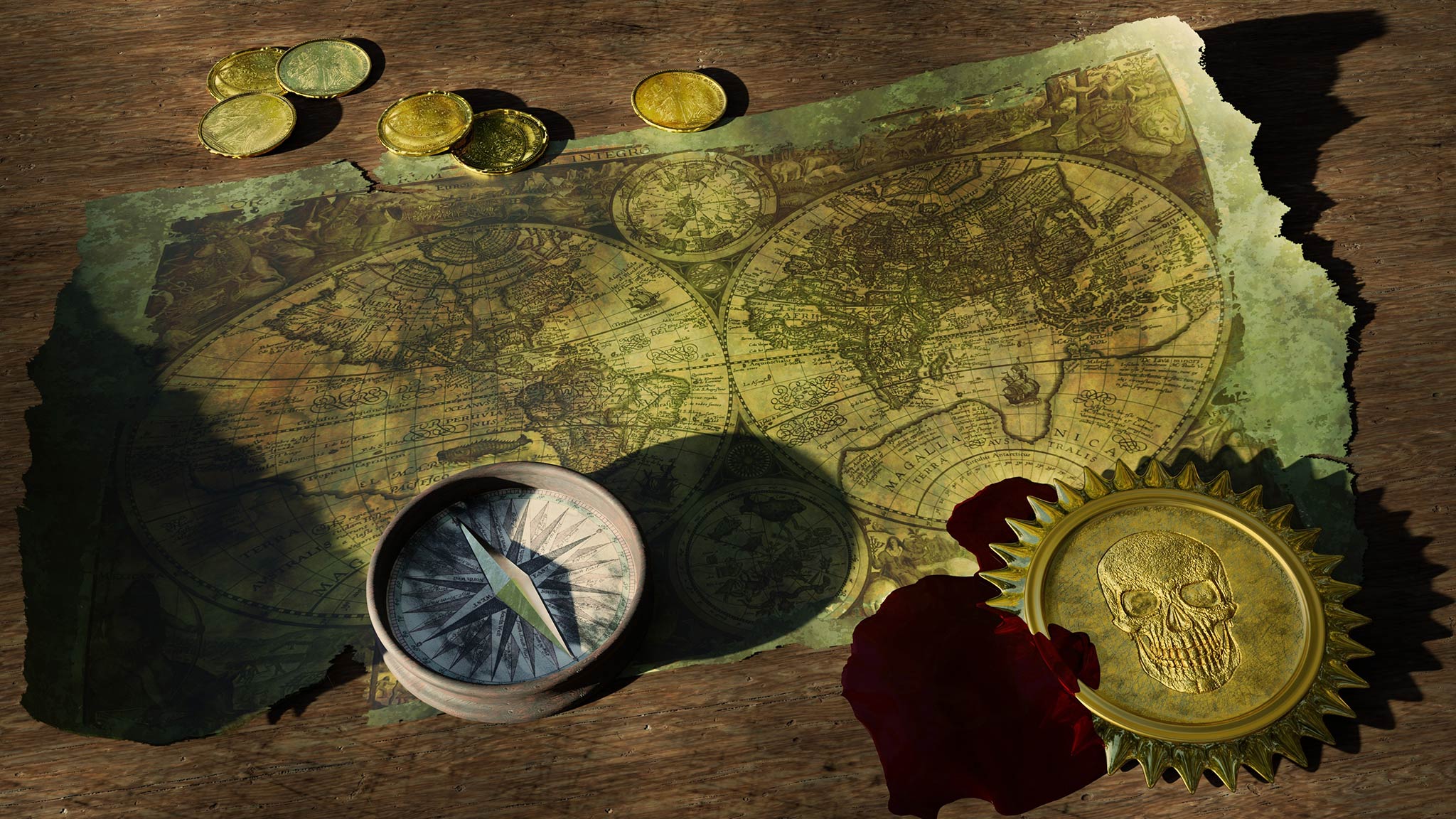These are the stories of the real Pirates of history - the men for whom shipwreck, starvation, disease, and violent death were a constant threat. Piracy has been around since man first took to the sea. It flourished when there was a lack of central control and in areas beyond the reach of major powers.
In recent years the period of piratical history from roughly the start of the 18th century until about 1730 has been dubbed the ‘Golden Age of Pirates’. This golden age produced some of the most famous pirates in history, men who now seem larger than life after centuries of romanticized accounts of their lives.
Pirates are often confused with Privateers. A privateer was a man or a ship under contract to a government, allowing it to attack enemy ships during wartime. A Pirate attacked any ship, regardless of its nationality. Sometimes the pirates themselves crossed the boundaries from one category to another.
From 1700 to 1715, the world was gripped in the War of Spanish Succession. It was a European conflict and is also known as the First True World War. In this war, both sides made extensive use of privateers in Caribbean waters for naval warfare. During these years privateering was a highly lucrative business, and places like Port Royal attracted merchant seamen in hundred, all eager for the opportunity of better working conditions and the chance of earning big money.
When the war ended, as many as 6,000 former privateers-all trained to prey on merchant shipping-found themselves unemployed, and the major British and colonial ports were soon filled with former privateers-all looking for work. Many were lucky, as when the war ended the British merchant fleet expanded dramatically. With more merchantmen at sea, the demand for sailors gradually increased, and many former privateers were more than happy to accept the poor condition and pay they were offered by merchant captains.
Others decided to use their privateering skills by continuing their private naval war, almost as if the peace had never happened. In other words they turned to piracy, but tried to cover their actions by maintaining a fiction of legitimacy. Consequently the end of war meant an increase in both pirates and potential victims, particularly British pirates and British merchantmen.
Like any criminals, in order to turn anything into money, the pirates needed to find someone willing to buy stolen property without asking too many awkward questions. For this they needed the right place. New Providence in Bahamas was ideal. It was close to major trade route and favourable winds allowed an easy passage to pirate hunting grounds.
By the summer of 1717 over 500 pirates were reportedly using the island as a base, serving in at least a dozen small vessels. Men such as Charles Vane and Blackbeard all passed through New Providence and called the island home during these few hardy years.
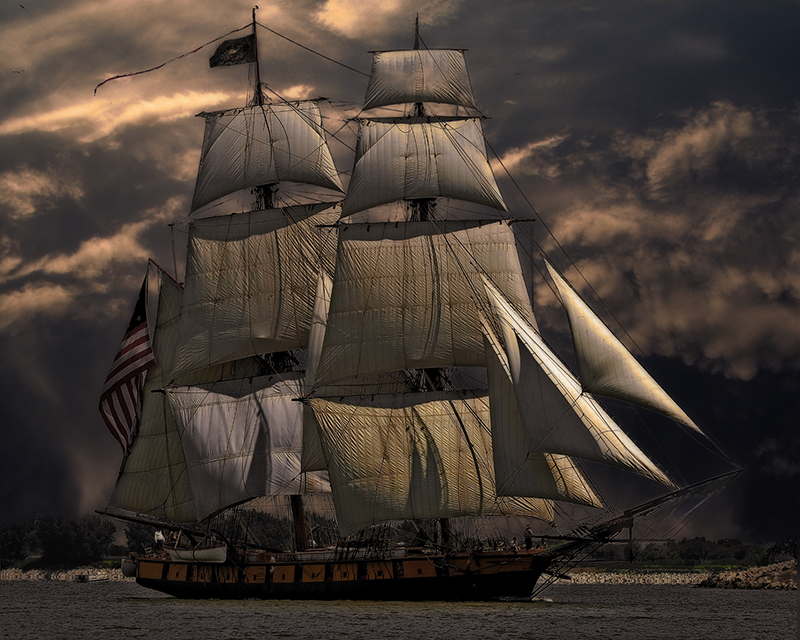
A Ship known as Sloop which was used by many Pirates.
As complaints about all the piratical activity reached London it was decide that something must be done. On September 5, 1717, King George I signed A Proclamation for Suppressing Pyrates. It granted a full pardon to any pirates who surrendered before September 5, 1718. Those who refused to accept the pardon would be hunted down, and a sizable reward would be offered to anyone willing to bring them to justice.
The effect was to create two political groups: one-the pro pardons-headed by Hornigold, who favoured accepting the offer, and the others –the die hards-led by Charles Vane, who refused to surrender. The British sent Woodes Rogers to New Providence to accept the pardon of 209 pirates and become the governor of the island. Just before nightfall on July 26, 1718, Rogers appeared off New Providence harbor with a squadron of seven ships.
The Die-Hards
That evening Vane bundled his 90 fellow hard-liners onto two sloops-his own vessel the Ranger and a recently captured French prize. He was well prepared, having stocked the prize with enough combustible materials to turn her into a fireship. He raised anchor and set course towards the entrance and Roger’s squadron. He tucked the Ranger in behind the now fiercely blazing fireship, and watched as British crews were forced to cut their anchor cables and make sail to avoid it. To add to the confusion Vane double-shotted the fireship’s guns, and these fired off in the heat. Her crew slipped overboard and rowed over to the Ranger, which managed to slip out of the harbor and escape into the darkness.
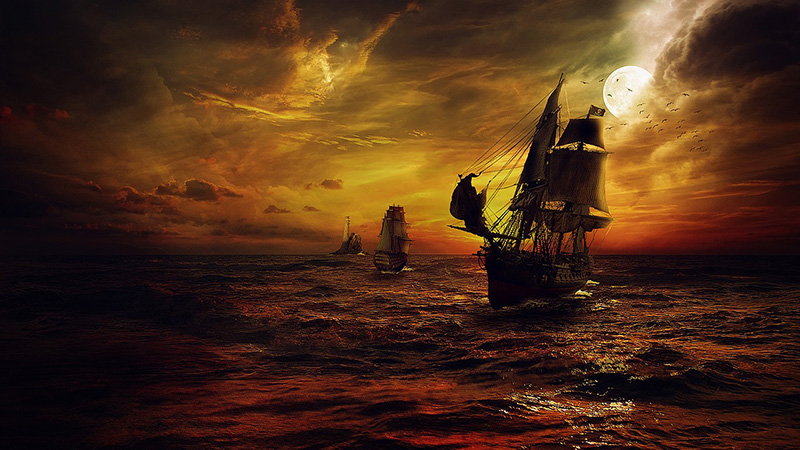
Charles Vane making his escape from Nassau.
By the time Charles Vane made his dramatic exit from New Providence in August 1718, he was already seen as one of the toughest pirates on the high seas. It was almost as if Vane was challenging Rogers to a duel. By September the Ranger was lying in North Carolina’s Outer Banks, a haven then being used by Blackbeard. The two pirate crews spent a week together and by all accounts they had a marvelous beach party. Then, with the onset of winter weather, the pirates decided to return to the warmer waters of the Caribbean.
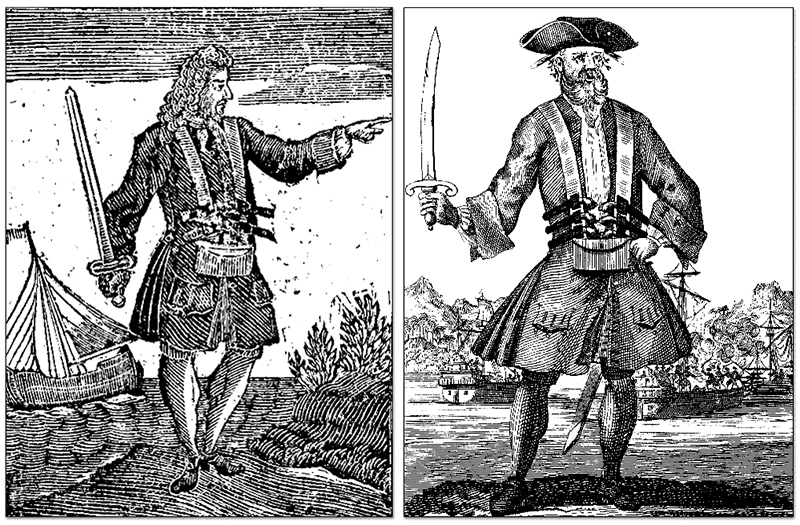
Charles Vane (left), Blackbeard (right)
By late November Charles Vane and his men had reached the Windward Passage between Saint Dominique and Cuba after a month long voyage which brought no prizes, no plunder, and no rum. The crew was already a little disaffected when, on November 23, they sighted a French merchantman. It seemed as if the Pirates’ luck had turned.
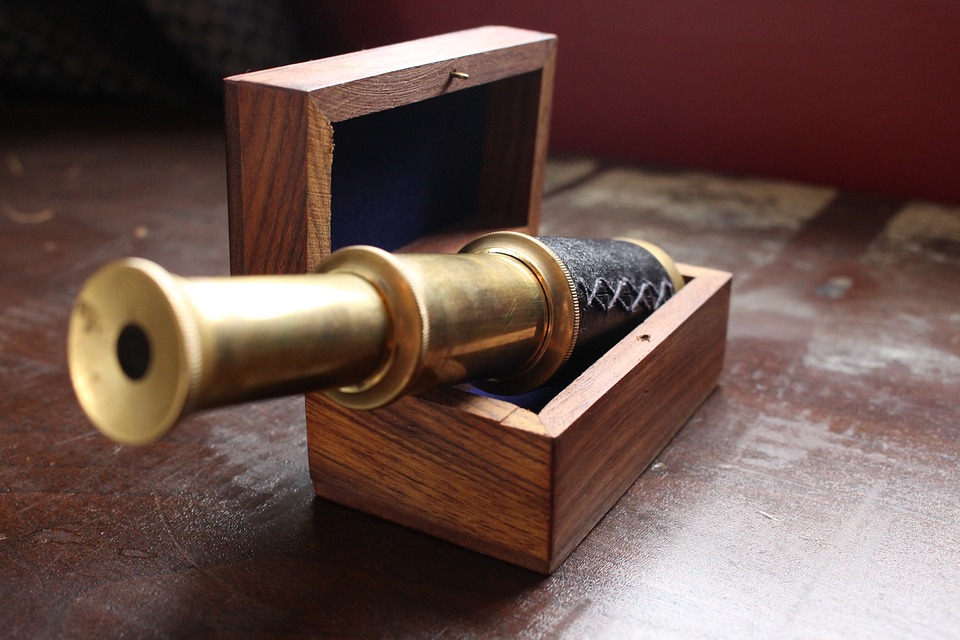
Telescope that pirates used to identify ships from afar.
Captain Johnson described what happened next:
They fell upon a ship, hoisted colors showed her to be a French man-of-war. Vane desired to have nothing further to say, but trimmed his sails, and stood away from the Frenchman; but Monsieur having a mind to be better informed who he was, set all his sails, and crowded after him. During this chase, the Pirates were divided in their resolutions what to do; Vane, the captain, was for making off as fast as he could, alleging the man-of-war was too strong to cope with; but one John Rackam, who was an officer that had a kind of check upon the captain, rose up in defense of a contrary position, saying that although she had more guns , and a greater weight of metal, they might board her, and then the best boys would carry the day.
Although Vane managed to have his way and the Ranger veered away from the French warship, the taint of cowardice was left behind in its wake. The quartermaster Jack Rackam called a vote, and a resolution was passed, branding Vane a coward and removing him from his captaincy. Rackam would be the next pirate captain.
At the time the Ranger was accompanied by a small sloop. Vane and 16 supporters were moved into her, and the Ranger, with its new captain, “Calico Jack” Rackam, sailed off into the sunset heading towards Jamaica.
Vane seemed undeterred by being left with a small sloop and a skeleton crew. He sailed round the north side of Jamaica, capturing a sloop on the way, then made landfall off what is now Belize in mid-December 1718. He established a base on an island and used this haven while he raided southwards into the Gulf. Then disaster struck. Sometimes in February 1719 a violent storm hit the two sloops and, after being pummeled by the seas for two days, Vane and his men were shipwrecked on a small island.
The pirate castaways survived for several weeks before a ship put in the island for water and the marooned men were rescued. The rescuers came to know who the castaways were, and Vane and his men were captured. By November 1719 Charles Vane was locked away in a Spanish Jail. His trial began on March 22, 1720. The condemned pirate was hanged and his body was displayed in a cage as a warning to others.
The capture and execution of Charles Vane was something of a triumph for the British authorities, and a stern warning to others. However Rackam was still at large. In December 1718 British declared war on Spain-a conflict that lasted just 14 months. The British government decide it needed privateers again, and so to boost numbers Woodes Rogers reissued his offer of a pardon.
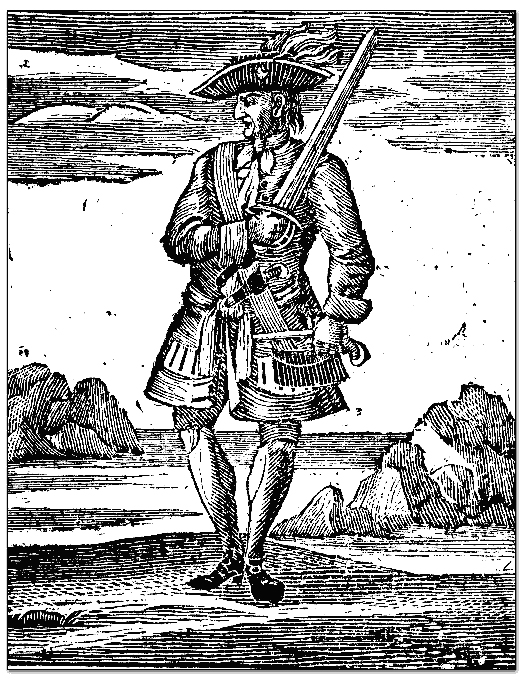
Calico Jack Rackam
Rackam and his die hards must have decided they had enough of being on the wrong side of the law, for in May 1719 Rackam applied for and was awarded a pardon. It seemed as if the last of the die-hards had hauled down their flag for good. It appears that the Ranger was sold off, which meant that the profits would have been divided amongst her crew of former pirates. Rackam and his shipmates would have made some effort to look for honest work, probably signing on as the crew of privateers. However, the end of the war in February 1720 ended that lucrative opportunity.
It was during this time that Rackam met Anne Bonney in New Providence, and when he decided he wanted to return to piracy, she left her husband and sailed with him. On August 22, 1720, Rackam and 13 of his followers including Anne, rowed out to the 12-gun sloop William, which was riding at anchor in Nassau harbor. They seized the ship and escaped before the authorities could stop them or give chase. Amazingly, one of the dozen men in his crew turned out to be another women – Mary Read, who had disguised herself as a man.
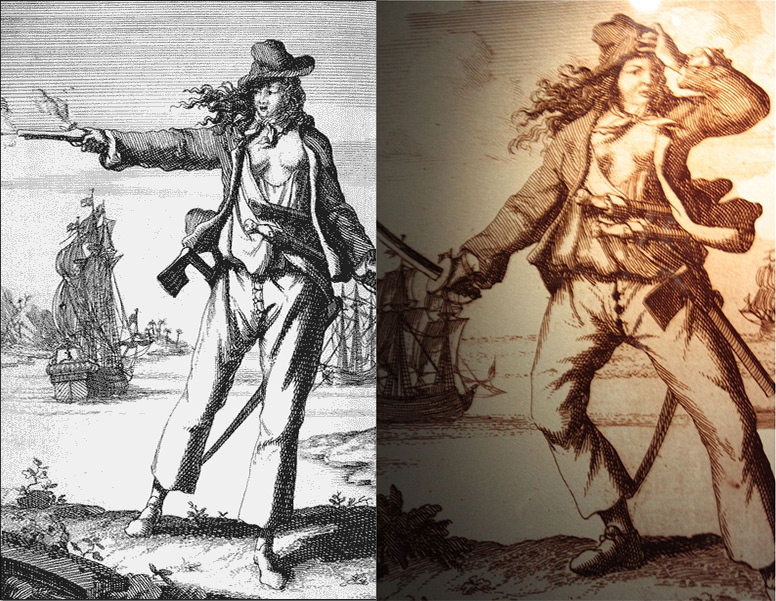
Anny Bonny (left), Mary Read (right)
Woodes Rogers responded by issuing a proclamation, which declared:
John Rackam and his said Company are hereby proclaimed Pirates and Enemies of the Crown of Great Britain
By October Rcakam had captured three vessels and was near Jamaica. The Jamaican authorities immediately sent the pirate-hunter Captain Jonathan Barnet in a 12-gun sloop Eagle, out to find Rackam. By mid-November the pirates dropped anchor on an island and started a drinking session. A few hours later Barnet was approaching the point from south when he heard the sound of musketry coming from closer inshore. He altered course to investigate and came upon William.
Rackam slashed his anchor cable and tried to escape, but within an hour the Eagle had overhauled them. Barnet ordered the pirates to surrender. They replied by firing swivel gun at the Eagle, and Barnet replied with a full broadside. Barnet boarded the William. Only Bonny and Read seemed to have been in a fit enough state to offer any resistance, cursing their drunken shipmates as they fought. These two firebrand women were soon overpowered, and the pirates were taken back to Spanish Town in chains.
On November 16, 1720, the Vice Admiralty Court tried and convicted Rackam and his nine male shipmates. The following morning “Calico Jack” was hanged along with others on Gallows Point- the same place where Charles Vane had met his end eight months before. As for the two women pirates, their arrest caused a storm of interest. After all, this was a time when women simply didn’t do that kind of thing. So began a public fascination with the lives of Anne Bonny and Mary Read that has never really gone away.
On November 28, 1720, the two women pirates were tried in the Vice Admiralty Court in Spanish Town, and like their male shipmates they were sentenced to be hanged. However, no sooner had the sentence been passed than they both claimed they were pregnant. It was not normal British policy to hang women, let alone ones with child, so the execution was delayed while a doctor was found to examine the pair.
It turned out that both were telling the truth, although exactly who the fathers were has never been explained. Rackam may well have been responsible-at least for the pregnancy of his partner Anne Bonny, although it was claimed that both women repeatedly offered themselves to their jailers, knowing that only pregnancy could guarantee their escape from the gallows.
Mary Read died in prison five months later, still carrying her unborn child. As for Anne Bonny,
She was continued in prison, to the time of her laying in, and afterwards reprieved from time to time; but what became of her since, we cannot tell; only this we know, that she was not executed.
Blackbeard
Blackbeard started his piratical career as one of Hornigold’s crew, sailing out of New Providence during 1716 and 1717. When he realized Blackbeard’s potential, Hornigold became his pirate mentor and raised his protégé to the rank of an auxiliary captain.
Hornigold always claimed he was a privateer rather than a pirate, a fiction that he supported by limiting his attacks to French or Spanish targets. In autumn of 1717, Hornigold’s faced a rebellion and his crew deposed him of his captaincy. Hornigold returned to New Providence to lead the pro-pardon group. Blackbeard then began operating on his own.
Edward Teach (Blackbeard) realized that for any violent criminal, intimidation was the key to success. If your opponent or victim is terrified of you before you have even raised a finger, then your task is made a lot easier. Blackbeard used his appearance as a weapon, both to intimidate his victims and to avoid unrest amongst his own crew.
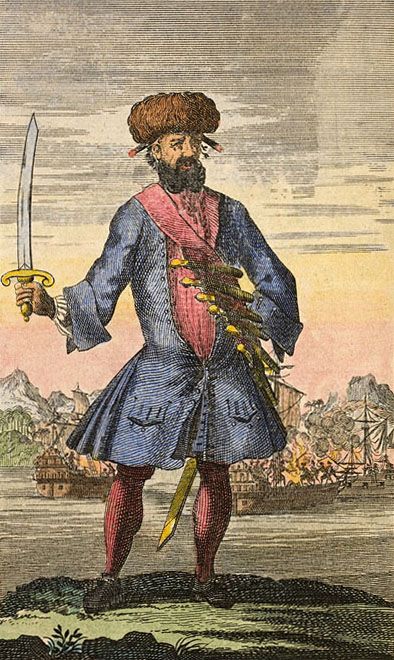
Edward Teach (Blackbeard)
By late September 1717 Blackbeard was off Cape Charles in Virginia, where he captured a sloop. After drinking her cargo of wine the pirates sank their prey, leaving her crew to row ashore in a longboat. The newspaper reported three other pirate attacks in the same area. He also captured three more prizes off the Virginia Capes and added another sloop to his force. Every time he captured a ship he also asked for volunteers to join his crew. This way he slowly built up his force.
By late October Blackbeard was off New Jersey. Lookouts spotted a large merchantman, and the pirates gave chase. She was overtaken and surrendered after only a token resistance. The Prize turned out to be La Concorde, a well-built 200-ton French slave ship. Teach led her into the secluded island of Bequia, where he set about converting her into his new flagship.
La Concorde carried 16 guns, but Balckbeard had been collecting artillery, storing the guns and carriages in the holds of his two sloops. These guns were moved to the slaver, which was being transformed into the ultimate pirate ship. Teach would have cut down her stern structure and forecastle to make her more suitable as a fighting ship and removed the slave decks from her hold. By the time he had finished, the new ship-which he renamed the Queen Anne’s Revenge carried no fewer than 40 guns, making her one of the most powerful fighting ships in the Caribbean.
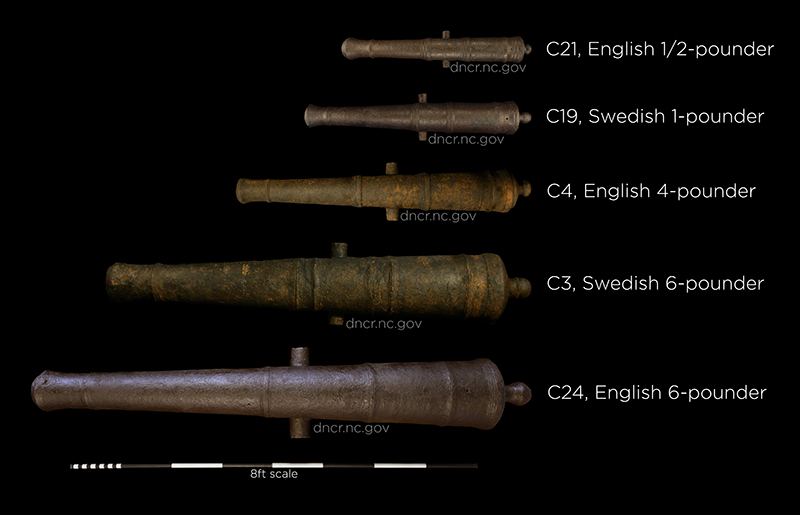
Types of cannons found on Queen Anne’s Revenge (Blackbeard’s Pirate Ship)
On his way he [Blackbeard] met with a pirate sloop of 10 guns, commanded by one Major Bonnet, lately a gentleman of good reputation and estate in the island of Barbados, whom he joined. But a few days after, Teach, finding that Bonnet knew nothing of a maritime life, and with the consent of his own men, put in another captain, one Richards, to command Bonnet's sloop, and took the major on board his own ship
Stede Bonnet
Stede Bonnet was a gentleman, a prominent member of colonial polite society. He bought and developed a sugar plantation outside Bridgetown, and by 1717 he was widely regarded as one of the more prosperous of the island’s plantation owners. He was considered highly respectable, having made a good marriage, involved himself in local politics, and become a major in the Barbados militia.
Then he threw everything away to become a pirate. Various reasons-a shrewish wife, a midlife crisis, or a major scandal-have all been suggested, but when questioned, his neighbours explained it by the onset of a “disorder of the mind.” Whatever the reason behind his decision, Bonnet set about everything in a most unusual way.
For a start he bought his own ship-something which any self-respecting pirate would simply not do. He opted for a large ten gun sloop, an ideal pirate vessel, which he renamed the Revenge. Exactly what wrong he was seeking to avenge was never made clear.
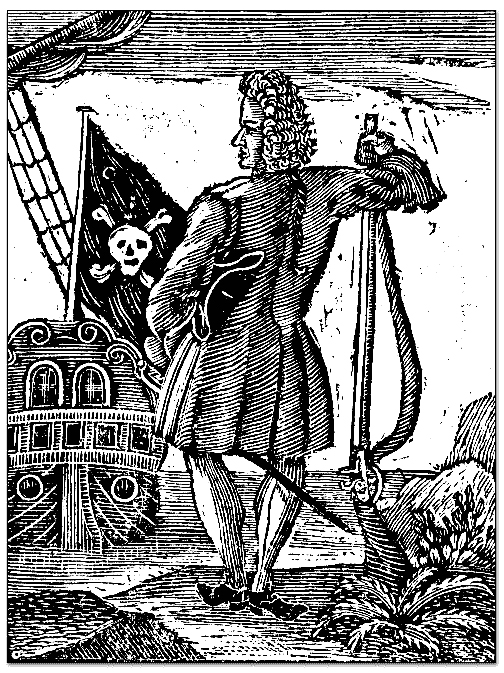
Stede Bonnet
He then combed the taverns of Bridgetown for a sailing master and crew. While all other pirates called for volunteers, the inexperienced Bonnet had little option but to hire them and pay them wages. In fact the 70 crew member of the Revenge were probably the only pirates in history to earn a regular income from their work.
He headed for the Atlantic seaboard of the American colonies, which he reached during early summer of 1717. He spent a month cruising off the Virginia Capes, where he captured four merchantmen. Bonnet further demonstrated his lack of understanding of pirate ways when he put in to a coastal settlement and bought rather than plundered the supplies he needed.
Bonnet took the Revenge back down to the Carolinas, and during September 1717, he ran into Blackbeard. Blackbeard suggested to the inexperienced Bonnet that he should allow the professional pirate to run his ship for him.
Blackbeard and Bonnet
On May 22, 1718, Blackbeard appeared off Charles Town in the province of South Carolina. By that time he commanded a powerful squadron of four ships, including Bonnet’s Revenge, his 40-gun flagship, and a force of some 250 men. With all that power, it must have felt as if the whole Atlantic seaboard of the American colonies lay at his mercy.
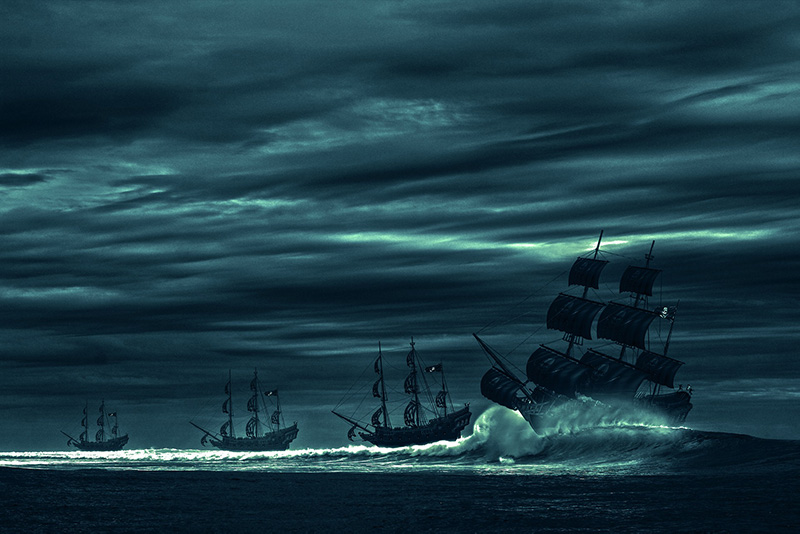
Blackbeard Squadron
A string of sandbars separated Charles Town harbor from the ocean, and so, by guarding the only gap in the bar that could be used by large ships, Blackbeard managed to blockade the port. His first victim was the pilot boat that came out to help the new comers over the bar. The pirates captured a few more unsuspecting prizes over the next few days. When the prizes dried up Blackbeard decide to be even more audacious.
Teach detained all the ships and prisoners, and, being in want of medicines, resolved to demand a chest from the government of the province. Holding a town to ransom was something of a new experience for the colonial Americans. While the South Carolina governor sent for help, he knew that time was not on his side. The nearest Royal Navy warships were in Virginia’s James River, and they would take a week to reach Charles Town.
Blackbeard had his medicine, but what he wanted it for has never been satisfactorily explained. A syringe for treating venereal disease found on the wreck site of what was almost certainly the Queen Anne’s Revenge may provide something of an explanation. We can only speculate, but evidently the pirates considered the chest even more important than any other form of plunder.
True to his word, Blackbeard raised the blockade and sailed off, heading north. He realized that if he delayed, the chances of being caught by Royal Navy warships would increase. What he needed now was a place where he could lie low for a bit, divide the plunder, and plan his next move.
Although there was no real chance of being offered a pardon by Woodes Rogers, and he had just infuriated the South Carolina colony’s governor, but he had other options. A pardon was still being offered by the colony of North Carolina. However, Blackbeard had one small problem to overcome first. His flagship was too large to operate in North Carolina’s sheltered waterways, and, prestigious though it was, it also acted as a direct challenge to the Royal Navy. Somehow he had to find a way to abandon her.
He hit on a perfect plan. On June 2, Blackbeard appeared off Topsail Inlet, near the modern town of Beaufort, North Carolina. In those days the town consisted of a few fishermen’s huts. The channel into the harbor was only 300 yards wide, and even at the time it was a tricky passage. Halfway through it. Blackbeard’s helmsman turned the Queen Anne’s Revenge hard to starboard, and she ran aground-hard. Queen Anne’s Revenge was a complete loss-exactly what Blackbeard had wanted.
The next part of the plan was to get rid of Major Bonnet. Using the excuse of the King’s Pardon, Blackbeard sent Bonnet off to the colony’s administrative seat in Bath Town, with instructions to obtain a provisional pardon for everybody from Governor Eden. He left in a local vessel, while Blackbeard still held on to the sloop Revenge.
Blackbeard hoped that by sending the less threatening Bonnet to see Eden first, the North Carolina governor would be more amenable when it came to Blackbeard himself. He then busied his men salvaging what they could from the wreck. Meanwhile 17 of Bonnet’s old crew prepared the Revenge for sea. Blackbeard then made his move.
He collected all of Bonnet’s men and marooned them on a deserted island across the inlet. Then he took the sails and cordage from the Revenge and sailed off in the Spanish prize, along with a small but carefully selected crew. A further 200 or so pirates were left on the beach in Beaufort. When Bonnet returned a few days later with a provisional pardon he was furious to discover that Blackbeard had pillaged his ship, stranded his crew, and absconded with the loot. That’s what comes of trusting a pirate.
After rescuing his own men. Bonnet re-crewed the Revenge from some of the other pirates whom Blackbeard had deserted. Bonnet took a week to set the Revenge to rights. When news came that Teach was at Ocracoke, the Revenge set off in pursuit. For once the name Revenge was appropriate for Bonnet’s sloop. He never caught up with Blackbeard, who by that time was safely hidden behind North Carolina’s Outer Banks.
As Johnson put it,
it happened too late, for he missed of him there, and after four four days’ cruise, hearing no further news of him, they steered their course towards Virginia.
By the time Revenge was at Ocracoke, Blackbeard was safely in Bath Town.
Teach made his way to Bath Town, and in mid-June he accepted the King’s Pardon from Governor Charles Eden and so officially turned his back on piracy. A reformed character, Blackbeard gave every impression of having turned over a new leaf. From that point on he would live off his piratical earnings. He divided the plunder, which of course was more substantial when split among 30 men than among 250.
This idyll would last for a few months during which time Blackbeard established another base on Ocracoke Island, in the Outer Banks. To keep his men occupied he took his sloop which he renamed Adventure, for little trips through the inland waters of the Outer Banks, and in September he even entertained Charles Vane and his men when they put in to the area after their escape from New Providence.
That was when Blackbeard decided to return to his own ways. He ventured further afield, and this time he encountered two French merchantmen. He attacked and pillaged them. For governor Alexander of Virginia, this was the final straw. He decide that he would deal with Blackbeard before he could become more of a threat.
Consequently he organized an assault. The man he entrusted with this naval enterprise was Lieutenant Robert Maynard, an experienced officer. Maynard sailed out on November 17, and reached Ocracoke Island four days later. Maynard decided to spend the night at anchor before approaching the pirate lair first thing in the morning. The next day on November 22, 1718, Maynard gave orders to get under way just before dawn.
The two sides were fairly even matched. A lookout on the Adventure spotted Maynard’s force as it rounded the southern tip of the island. The pirate crew was roused, and a gun was fired at the Maynard’s sloop. The battle had begun-a fight that would be remembered as one of the smallest yet the bloodiest and most significant pirate engagements in history.
Maynard ordered the flags to be unfurled, and his sloop turned towards the enemy, the ships abreast of each other. Fortunately for Maynard, the pirates either didn’t fire their guns effectively or didn’t fire at all. When the two sides were within a hundred yards of each other the two captains hailed each other. Maynard recorded the conversation:
At our first salutation he (Blackbeard) drank Damnation to me and my men, whom he stilled cowardly puppies, saying ‘He would neither give nor take Quarter’
A broadside the ripped into Maynard’s sloop, killing six and wounding ten of his men. It seemed that Blackbeard was getting better of the navy. Maynard stayed afloat-realizing the pirates planned to board him-he hid most of his crew below decks. Just before the two ships crashed into each other, Blackbeard gave the order to throw grenades onto the enemy’s deck. He then shouted that the enemy were,
All knocked on the dead, except three or four, and therefore let’s jump on board and cut them to pieces.
At that moment Maynard’s men surged up from below decks. The hand to hand fighting that followed was brutal, with no quarter on either side. In the midst of the swirling melee, Blackbeard and Maynard singled each other out and fought their own form of duel.
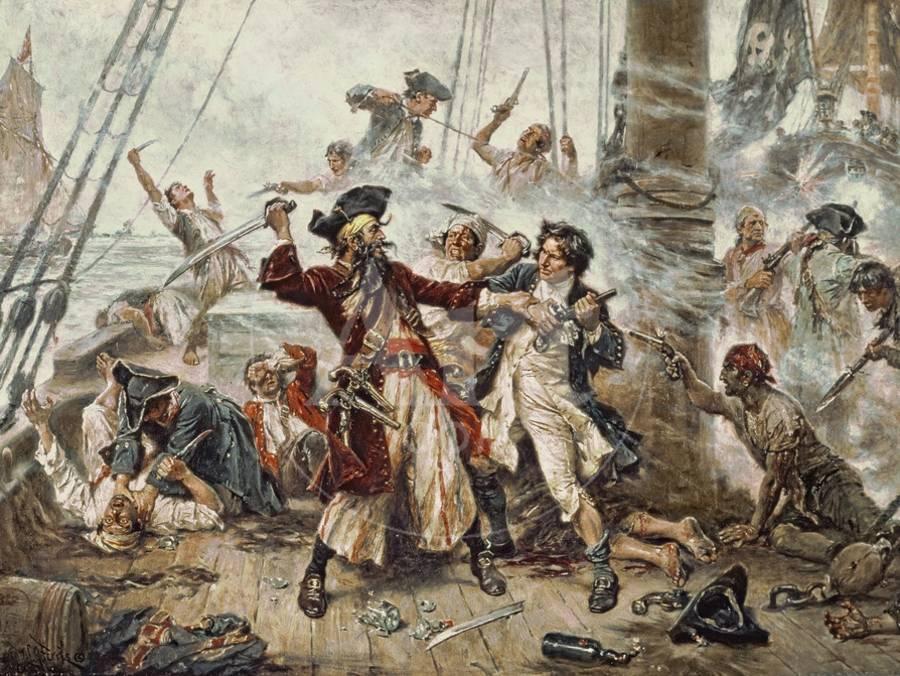
Blackbeard vs Maynard
Blackbeard and the lieutenant fired a pistol at each other, by which the pirate received a wound.
The pirate then drew a cutlass, which he swung at Maynard.
Maynard and Teach themselves begun the fight with their swords, Maynard making a thrust, the point of his sword went against Teach’s cartridge box, and bended it to the hilt. Teach broke the guard of it, and wounded Maynard’s fingers but did not disable him, whereupon he jumped back and threw away his sword and fired his pistol, which wounded Teach.
The pirate had now been hit twice by pistol shot, but he still kept fighting.
With Maynard’s sword broken, Blackbeard moved in to deliver a killing blow. At that moment one of Maynard’s men slashed at Blackbeard, cutting his throat with his sword. Blackbeard remained on his feet, but he was mortally wounded. As he was cocking another pistol he fell and was dead by the time he hit the deck. Blackbeard-the most notorious pirate of his age-was now dead.
Even after Blackbeard this Golden Age produced many more pirates, some of whom also did great and terrible things but there were also other pirates who didn’t do as many or no terrible deeds so we don’t know much about them as their tales weren’t fantasized by people. What can be said for sure is that their fate was more or less the same as Blackbeard or other Pirates we know about because they also sailed with the Black Flag or Jolly Rogers as it is known.
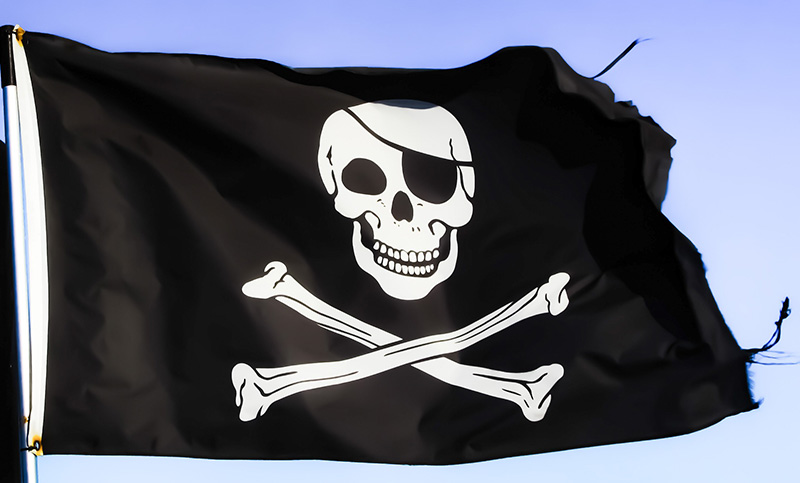
Jolly Roger
The piratical journeys of all pirates lasted no more than a few years before they were put down by governments of the world. Sure pirates like Blackbeard deserved to be put down but even after all the troubles he had caused, he was still given a pardon just so that he would give up his pirate ways. It can be ascertained that perhaps there was something very threating in the idea of being a pirate.
That idea is what lead people like Stede Bonnet who were well off and respected, into the piracy business. Hoisting the black flag meant that you were living freely without anyone’s rules but your own. And this idea spread like fire during the Golden Age among those privateers who put their lives on the line to fight someone else’s war and in the end were excluded when their services were no longer required.
